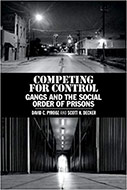Competing For Control: Gangs and The Social Order Of Prisons

Authors: David C. Pyrooz and Scott H. Decker
Publisher: New York:Cambridge University Press, 2019. 312p.
Reviewer: Kerryn E. Bell | July 2020
Research on gangs is accumulating. Many studies have examined gangs in street settings, but very few have done so within institutional settings such as prisons. Competing for Control discusses the Lone Star Project begun in Texas in 2014. It is a unique and extensive contrast of the experiences of gang members on the streets and in prison, using both interviews and official prison data. The sample is 802 people (368 gang and 434 non-gang inmates) who served as the baseline interviewees in prison and were re-interviewed twice after they returned to the community. Interviews were conducted in the Huntsville and Estelle prisons between April and December, 2016. The book focuses on the baseline interview and meticulously uses test of reliability and validity to support the results.
The authors discuss three domains of gangs: activities, culture, and social organization. They incorporate four theoretical perspectives: the traditional deprivation and importation models of prison; emerging governance perspectives; group structural perspectives (including prison gang members considered part of a Security Threat Group (STG)); and group process perspectives on how groups influence collective and individual behavior.
The book provides some interesting and surprising findings. Demographically, gang members are younger, more likely to be Latino, and less educated than non-gang members. Gang members report better health than non-gang members, but also greater stress and exposure to violence. Interestingly, while we have assumed differences between street and prison gangs, the inmates do not describe the gangs as “street-based” or “prison-based,” as most indicate their gang operates on both the street and in the prison. In fact, the study shows that gang members do not see much difference between street and prison gangs at an instrumental, expressive, profit-generating, or communication level.
Another interesting finding is that the control exercised by gangs extends primarily just to gang members. While previous studies postulate that prison gangs contribute to the rules and social order of the prison, the current study finds that role is limited to gang members only, and is not given credence by non-gang members. In addition, while gang members still commit more violence and prison infractions, they do not control prison violence and contraband as they once did, and it has become easier to avoid joining a gang in prison. Another surprising finding is that gang members can and do exit the gang without violence. The authors state that it is more common to leave a gang than to join one in prison. This indicates that leaving a gang is possible – a finding that flies in the face of most prior research, and is contrary to the fears of many gang members. In fact, the method for leaving a gang rather than being sworn or beaten out is, according to this research, simply a process of “giving notice” that the individual is terminating their gang membership.
Overall, this is a very well-researched book. A shortcoming that is acknowledged by the authors is that they studied only male gang members. Despite this, the study is still an excellent source for comparing street and prison gangs.
Kerryn E. Bell, Associate Professor, Eastern Washington University.


